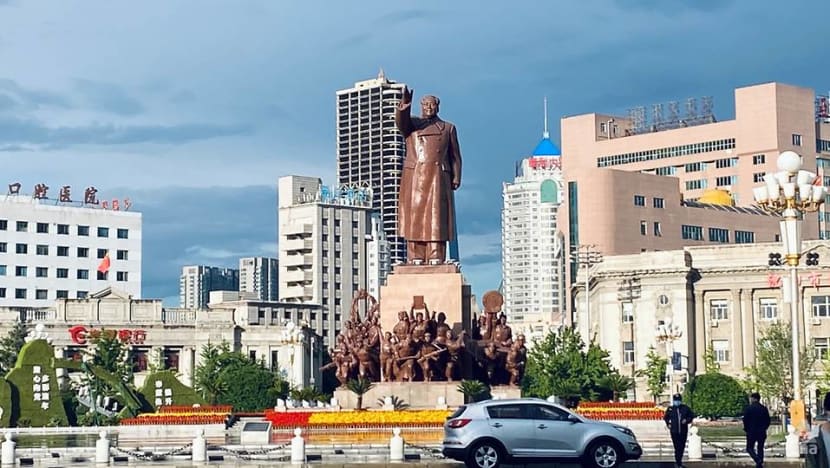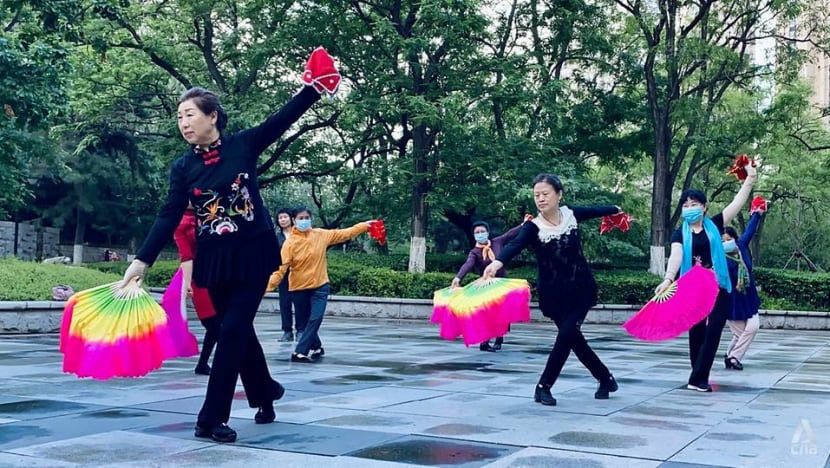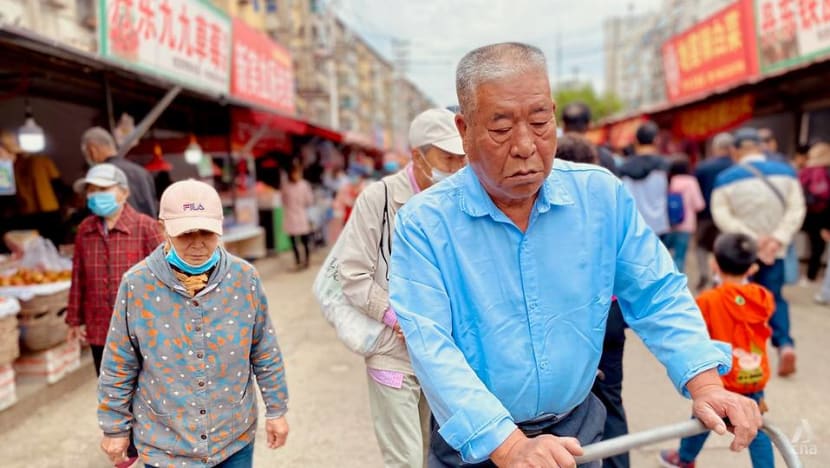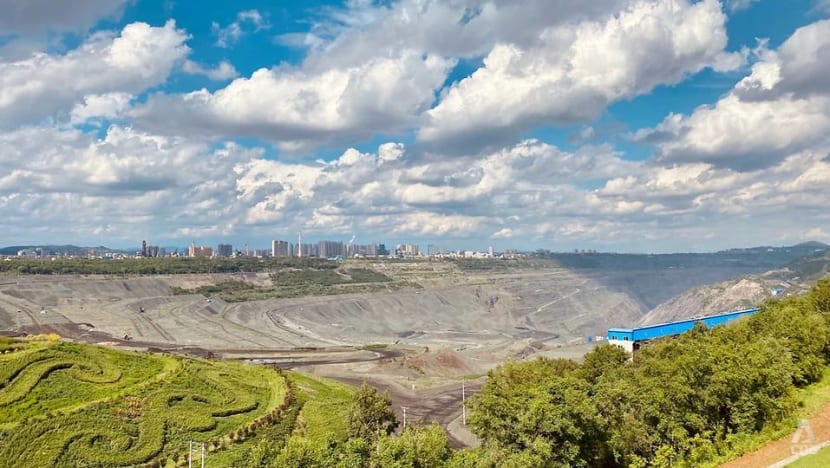'Everything is different now': China's rust belt presents challenges as Communist Party marks 100th anniversary

Retiree Shi Wancai, 76, at the site of his former workplace in Shenyang. (Photo: Olivia Siong)
SHENYANG, Liaoning: The monotonous purr of traffic on Zhaogong South Street is interrupted incessantly by the whirrs and chatter from a small row of car workshops. Rising up from behind - a block of peach coloured low-rise apartments. The smell of paint is unmistakable as one walks by.
"Everything is different now," 76-year-old retiree Shi Wancai tells me, becoming visibly emotional.
"My feelings are complicated, the times are changing. Doesn't that mean I'm just getting older?"
Shenyang was where Mr Shi spent decades of his youth. He was dispatched to the city when he was just 20; assigned straight out of school to work in an engineering state-owned enterprise.

INDUSTRIAL NORTHEAST
Mr Shi would have once ridden his bicycle to his workplace on this very site, and along with up to 3,000 workers, stepped in for a full day's work at one of the large factory workshops.
Such state-owned companies and heavy industries were the lifeblood of China's northeast region - the country's first major industrial base.
It comprises the provinces of Jilin, Heilongjiang and Liaoning, of which Shenyang is the provincial capital.
The region was even christened the country's "laoda", or eldest son, by the late Communist Party chairman Mao Zedong.

To Mr Shi, the northeast's most glorious period was the 1950s.
"One felt very proud (to be a worker) because those in the northeast were the 'eldest' and the south didn't have any heavy industries," he said.
"It was an old industrial base, which at the time provided resources around the country with the region's steel, coal … but now it can't sustain it anymore."
READ: Marking centenary, China heralds Communist Party's influence
RUST BELT
Today, the region is known as China's rust belt.
Things started to change in the 1980s when then paramount leader Deng Xiaoping embarked on his reform and opening up campaign.
This switched China from a centrally planned economy to one that embraced market forces, a move that would completely transform the country and turn it into the economic powerhouse it is today.
Resources were focused on China's southern regions, like Shenzhen and Guangzhou, which for the northeast, meant falling demand for heavy industries and a series of worker layoffs.
While Mr Shi was spared, he said it was a confusing period for many.
"I needed to go into business and it was not like in the past where the company would arrange for you to work," said Mr Shi.
"You had to depend on yourself and not only did you have to ensure you had an income, you also had to do that for other people. There was a lot of pressure."
The northeast's economy accounted for about 14 per cent of the nation's gross domestic product in 1978. It was just 6.3 per cent in 2018.
Last year, the economies of Liaoning, Heilongjiang and Jilin grew at 0.6 per cent, 1 per cent and 2.4 per cent respectively – either far below or only slightly above the country's overall 2.3 per cent GDP expansion.
READ: China's ruling party censors its past as centenary nears
Many have attributed the underperformance to the dominance of inefficient state-owned enterprises, dubbed zombie companies that are being kept alive only by government investments.
"They are still talking about revitalising northeast China and there are things that they are doing," said Mr Shi of the government's ongoing efforts.
"But I don't think it's developing as quickly as other parts of China, like Beijing, Shanghai, Guangzhou. It's just not as fast."
AGEING POPULATION
Adding further strain to the northeast's moribund economy is China's rapidly ageing population.
Sixteen per cent of the population in the northeast is above the age of 65 – about three percentage points higher than the national figure.
It's been estimated that a third of China's population will be older than 60 by 2050. In 2019, the Chinese Academy of Social Sciences warned that state pension funds could run out as early as 2035.

They joke that they stay active in order to live to a ripe old age, but also readily admit that it is also because they do not want to burden their children.
China implemented a one-child policy for decades to curb a rapidly growing population. The policy was relaxed in 2016 and this year, China allowed families to have up to three children.
READ: Three-child policy - China lifts cap on births in major policy shift
"We all have one child, they are all busy working and looking after their children and they wouldn't consider our ageing issues," 64-year-old retiree Song Ying says.
"If our pension is low and we need to hire someone to look after us, then wouldn't our expenses go up? There's also the cost of getting (medical) treatment."
Her 68-year-old sister Song Juan, adds that just buying medicine is a large financial burden, without even taking into account what would happen if one had to be admitted to hospital.
This issue though, Mr Shi says, is not one of filial piety, but that of an ageing society.
"There are pros and cons. The pros are that medical care has become more advanced, living standards have gone up, and life expectancy has gone up," he said.
"But, the cons are that we now have an ageing population. With only one child, how can we resolve this issue? There is a limit to resources."
Mr Shi says he is glad that the Chinese leadership has at least acknowledged the problem.
"There are various issues to resolve and at the moment it's challenging. We also face pressure. For example, if there are nursing homes, with our financial resources, we may not be able to afford it," he added.
Mr Shi receives a pension equivalent to US$470 every month.
"DOUBLE WHAMMY"
Experts have pointed to the impact on China's working population.
"It's kind of the engine of China's economic growth and it's the engine of China's rise as a superpower," said Dr Ye Liu, senior lecturer of international development at King's College London.
She added that the working population aged between 16 and 64 will shrink by about 10 per cent by 2050, while those who reach retirement age will double in numbers.
"It is kind of a double whammy and a smaller, slimmer labour force is kind of trouble for economic development," she said.
"I think that's the kind of economic rationale behind all the demographic policy, social policy."
For now, Mr Shi lives alone in an apartment in Shenyang. His daughter and grandchild moved to Beijing, where the husband works.
"Of course if it were up to me, I wouldn't want her to be there. But it's for her child and her future, that's why I support her," said Mr Shi.
"They have to see the world."
"THIS IS HOME"
The northeast's decline has led to people moving to other parts of the country in search of work and better opportunities. The region's population has shrunk by 11 million over the last decade.
About 60km away from Shenyang is Fushun. The city - once nicknamed the capital of coal - has struggled to deal with a decline in its mining industry and an outflow of people. The young people who choose to stay put cite family as a reason.

"Development-wise, Fushun can't compare to the big cities. But there are joys in being in a small city, where it's not as stressful," says a 28-year-old teacher who declines to be named.
"I thought of leaving the region when I was in school. But after living in a small city for so long, I still like it because this is home."
Father of one, Xu Feng, says the difference in the northeast's development is evident when he travels for work to the south of China.

But he quickly adds that he still has confidence in the Communist Party.
"It doesn't mean that if our region is not developing well, that overall, the country is not doing well. You can see the development is quick and the northeast in the initial years has also contributed greatly.
"Right now, some of the old industries may not be around, but there will be new sources of income."
SOCIAL CHALLENGES
Observers have said China will need to pay greater attention to regional disparity, as it brings about a host of issues, including social challenges.
"Regional disparity, I think, also poses a long-term threat to governance, because according to socialist ideology, all regions should have an equal chance of developing its economy," said Dr Chen Gang from the East Asian Institute at National University of Singapore.
"I think the government's already tried very hard to develop those economies, but the results have been far from satisfactory. So I think the future, they really need to think about some new policies, or need to have some innovations to grow those economies."
Rural flight is another issue.
The latest census data showed that 493 million people, a third of China's population, live outside the townships or streets where they are officially registered - an increase of 55 million from 2010.
Aside from accelerating the economic decline of rural areas, this rapid urbanisation also brings about a host of other issues. Under China's restrictive hukou system, migrants from rural areas have limited access to city services like schools and hospitals.
"If the person is located in a rural area, he or she still has a piece of land on which they can grow something to feed themselves and their families. But once they go to urban areas, I think they may lose a job and they may lose everything," said Dr Chen.












